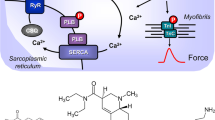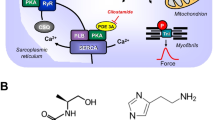Summary
Although 5-hydroxytryptamine (5-HT) increases porcine atrial force and rate via 5-HT4 receptors, its effect on left ventricular contractility is not known. Therefore, using the maximum rate of rise of left ventricular pressure (LVdP/dtmax) as an index of cardiac contractility, we have attempted to analyze the possible role of ventricular 5-HT4 receptors in the anaesthetized pig. The full agonists at 5-HT4 receptors, 5-HT and 5-methoxytryptamine (each 3, 10 and 30 μg · kg−1), and the β-adrenoceptor agonist, isoprenaline (0.01, 0.03 and 0.1 μg · kg−1), increased heart rate, LVdP/dtmax and cardiac output. For a given degree of tachycardia, the increase in LVdP/dtmax by isoprenaline was substantially more than that observed with either 5-HT or 5-methoxytryptamine. The 5-HT4 receptor partial agonist, renzapride (3, 10, 30, 100 and 300 μg · kg−1), also increased heart rate and LVdP/dtmax dose-dependently. When the heart was paced at 150 beats · min−1, increases in LVdP/dtmax as well as cardiac output (except with the highest doses) by 5-HT, 5-methoxytryptamine and isoprenaline were clearly attenuated. However, the magnitude of attenuation of LVdP/dtmax responses by cardiac pacing was more marked in the case of 5-HT and 5-methoxytryptamine than with isoprenaline.
The effects of renzapride (300 μg · kg−1) and tropisetron (0.3 and 3 mg · kg−1) on increases in heart rate and LVdP/dtmax by 5-HT, 5-methoxytryptamine and isoprenaline were also studied. In the absence of atrial pacing, both renzapride and tropisetron (3 mg · kg−1) effectively antagonized the responses to 5-HT and 5-methoxytryptamine; except for some decrease in the LVdP/dtmax response by tropisetron, the effect of isoprenaline remained essentially unchanged after the antagonists. During atrial pacing, renzapride significantly antagonized the responses to the first two doses of 5-HT, but the responses to the highest 5-HT dose and to 5-methoxytryptamine remained unaffected. Though, particularly after its higher dose, tropisetron reduced the responses to 5-HT and 5-methoxytryptamine, isoprenaline responses were also affected.
The above results show that a significant part of the increase in LVdP/dtmax by 5-HT receptor agonists in the anaesthetized pig is a consequence of tachycardia elicited by these compounds via 5-HT4 receptors. Since the increase in LVdP/dtmax, compared to tachycardia, was much less with 5-HT and 5-methoxytryptamine than with isoprenaline, and since the antagonism by renzapride and tropisetron against 5-HT and 5-methoxytryptamine during atrial pacing was relatively weaker and/or unspecific, it appears unlikely that the increase in LVdP/dtmax, during atria] pacing is mediated by ventricular 5-HT4 receptors. This view is substantiated by our recent in vitro experiments where 5-HT (0.01 to 100 μmol/l) failed to significantly increase contractions of porcine left ventricular trabeculae.
Similar content being viewed by others
References
Bom AH, Duncker DJ, Saxena PR, Verdouw PD (1988) 5-HT-induced tachycardia in the pig: possible involvement of a new type of 5-HT receptor. Br J Pharmacol 93:663–671
Brodde O-E (1991) β1 and β2-adrenoceptors in the human heart: properties, function and alterations in chronic heart failure. Pharmacol Rev 43:203–242
Dumuis A, Bouhelal R, Sebben M, Bockaert J (1988) A 5-HT receptor in the central nervous system, positively coupled with adenyl cyclase, is antagonized by ICS 205–930. Eur J Pharmacol 146:187–188
Dumuis A, Sebben M, Bockaert J (1989) The gastrointestinal pro-kinetic benzamide derivatives are agonists at the non-classical 5-HT receptor (5-HT4) positively coupled to adenylate cyclase in neurons. Naunyn-Schmiedeberg's Arch Pharmacol 340: 403–410
Duncker DJ, Saxena PR, Verdouw PD (1985) 5-Hydroxytryptamine causes tachycardia in pigs by acting on receptors unrelated to 5-HT1, 5-HT2 or M-type. Br J Pharmacol 86:596P
Kaumann AJ (1990) Piglet sinoatrial 5-HT receptors resemble human atrial 5-HT4-like receptors. Naunyn-Schmiedeberg's Arch Pharmacol 342:619–622
Kaumann AJ, Brown AM, Raval P (1991) Putative 5-HT4-like receptors in piglet left atrium. Br J Pharmacol 102:98P
Saxena PR (1986) Nature of the 5-methoxytryptamine receptors in mammalian heart. Prog Pharmacol 6:173–185
Saxena PR, Villalón CM (1990) Cardiovascular effects of serotonin agonists and antagonists. J Cardiovasc Pharmacol 15 [Suppl 7]:S17-S34
Saxena PR, Villalón CM (1991) 5-Hydroxytryptamine, a chameleon in the heart. Trends Pharmacol Sci 12:223–227
Schoemaker RG, Du XY, Bax WA, Saxena PR (1992) 5-Hydroxytryptamine increases contractile force in porcine right atrium but not in left ventricle. Naunyn-Schmiedeberg's Arch Pharmacol (in press)
Scholtysik G, Imoto Y, Yatani A, Brown AM (1988) 5-Hydroxytryptamine antagonist ICS 205–930 blocks cardiac potassium, sodium and calcium currents. J Pharmacol Exp Ther 245:773–778
Villalón CM, Den Boer MO, Heiligers JPC, Saxena PR (1990) Mediation of 5-methoxytryptamine-induced tachycardia in the pig by the putative 5-HT4 receptor. Br J Pharmacol 100:665–667
Villalón CM, Den Boer MO, Heiligers JPC, Saxena PR (1991) Further characterization, by use of tryptamine and benzamide derivatives, of the putative 5-HT4 receptor mediating tachycardia in the pig. Br J Pharmacol 102:107–112
Author information
Authors and Affiliations
Additional information
Correspondence to P. R. Saxena at the above address
Rights and permissions
About this article
Cite this article
Saxena, P.R., Villalón, C.M., Dhasmana, K.M. et al. 5-Hydroxytryptamine-induced increase in left ventricular dP/dtmax does not suggest the presence of ventricular 5-HT4 receptors in the pig. Naunyn-Schmiedeberg's Arch Pharmacol 346, 629–636 (1992). https://doi.org/10.1007/BF00168735
Received:
Accepted:
Issue Date:
DOI: https://doi.org/10.1007/BF00168735




